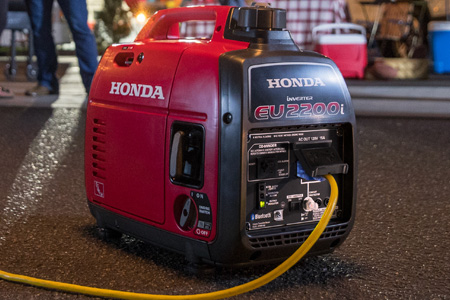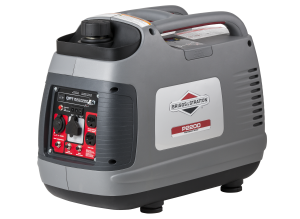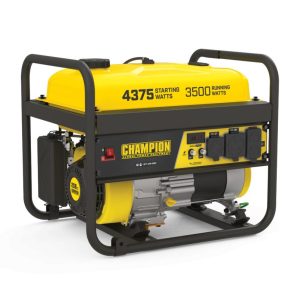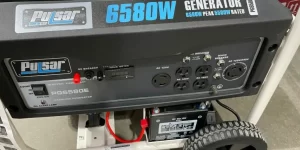16 Causes Your Honda Generator Won’t Kick On
If there isn’t enough air, spark, or fuel, a Honda generator won’t turn on. The gasoline tank may be empty, the fuel filter may be clogged, the fuel line may be clogged, the carburetor may be dirty, the air filter may be blocked, the spark arrestor may be clogged, the spark plug may be bad, the ignition coil may be defective, the gas cap may be loose, or the engine oil level may be low.
A dead battery, defective ignition switch, or malfunctioning starter solenoid could prevent a Honda electric-start generator from starting.
To avoid harm, be sure to observe all of the safety measures recommended in your Honda’s manual. The spark plug wire must be removed, and the engine must be allowed to cool, before any repairs can be made.

Table of Contents
Reasons Your Honda Generator Won’t Start
Honda Generator with an Empty Fuel Tank
You know that gasoline is needed to run your Honda generator, but either a leak has arisen or the tank has been left empty.
This is such a no-brainer, but I had to point it out because frustrated generator owners often overlook it before getting to the bottom of the problem.
Put fresh gas in the tank, that’s the answer. Honda’s four-cycle engine generators run on gasoline. Honda’s 2-cycle generators can only run on a combination of gasoline and oil.
Honda Generator Damaged by Old or Corrupt Fuel
Gas might lose its quality and efficiency as early as 30 days after purchase, which you might not know. Degradation of ethanol is accompanied by its ability to draw water into the fuel system.
Ethanol, which is typically produced from maize or another high-starch plant, is an alternative fuel that is gentler on the environment. Varnish and sticky deposits caused by ethanol and the moisture it attracts can cause component failures and fuel limits.
Honda generators are not designed to run on ethanol, so the following should be kept in mind at all times:
- Get some fresh gas with a minimum octane of 87 (91 RON).
- Never fill up with fuel that has more than 10% ethanol in it. Ethanol-free and low-ethanol fuels perform the best.
- Put the gas to good use within 30 days.
utilize a gasoline stabilizer to extend its shelf life if you won’t be able to utilize it within 30 days. (A fuel stabilizer is required for fresh fuel.) Used fuel’s effects won’t be reversed by this. - Keep gasoline in a certified fuel container, away from water and flammable substances.
A gasoline siphon pump can be used to remove stale gas from your Honda generator if you ever find yourself in this predicament. Fresh gas and a fuel additive work together to clean the fuel system, cut down on moisture, and stabilize the gas.
Be sure to fill up on petrol. After starting the generator, let it run for 15 minutes to allow the gas and stabilizer mixture to circulate through the fuel system.
I really like the Sea Foam Motor Treatment. Every time I fill up my gas tank, I add this product to mitigate the potential issues with ethanol-based petrol. The use of STA-BIL is an alternate choice.
Honda generators powered by 2-cycle engines require a fuel tank mixture of gas and oil. If you have a 2-cycle engine, DO NOT use regular gas.
Honda Generator Fuel Filter Clogged
Inspect the fuel filter of the generator. Dirt in the gasoline system can cause engine wear, therefore this filter is added to catch it.
A good flow of fuel is inhibited when the filter is allowed to become clogged with dirt and deposits and is not regularly changed. The shortage of gasoline prevents the generator from starting.
The typical homeowner should change the gasoline filter once a year. The Honda generator could require more frequent replacements if they are used often.
Resolved: Fuel filter replacement for a Honda
Honda Generator Fuel Line Clog
Leftover deposits from stale fuel can cause obstructions in fuel delivery systems. Turn off the gasoline supply for a moment so it can be checked, then turn it back on again.
Once the fuel has been turned off, the end of the fuel line farthest from the tank should be disconnected and stored safely. Bring fuel into the container and keep an eye on how much is coming in.
This container needs to be situated at a lower level than the fuel tank, as fuel cannot flow uphill without a pump.
If you discover a clog in the fuel line, the solution is to turn off the fuel flow and separate the fuel line from the generator. To break up the obstruction, spray the carburetor with cleanser.
If you find that the gasoline line is dry or cracked, or if you are unable to remove the restriction, you should replace it with a new fuel line of the same diameter and length.
An Issue with a Honda Generator’s Carburetor
A Honda generator’s carburetor regulates how much fuel is combined with air before being combusted.
The components of a carburetor stop working when it gets dirty from varnish buildup from stale fuel. The generator won’t start if the fuel jet is clogged, the float is jammed, or the float needle is stuck.
Before you start taking out the carburetor to clean it, make sure it’s getting enough fuel. If you aren’t, maybe there’s a blockage in the fuel system somewhere between the fuel tank and the engine.
After isolating the fuel restriction’s origin, the carburetor must be removed as the solution. Carburetor cleaning is useful for eradicating as much residue as feasible.
The float, float needle, and fuel jet in the carburetor should be inspected for cleanliness and proper operation. A carburetor refurbishment kit or a new carburetor should be used to replace any worn or broken components.
Honda Generator Clogged Air Filter
The air filter serves to safeguard the engine by keeping foreign matter such as dirt and debris from entering the air intake. If the air filter is clogged, less air is available to be burned with the gas.
If you run your Honda generator in dusty conditions, you should change the air filter more often than once a year. In between filter replacements, you should inspect and clean it regularly.
If you don’t regularly clean and change the filter, it will get so dirty that the engine won’t get enough air to start. The engine could overheat and be severely damaged if this happens.
When a foam air filter becomes clogged, the solution is to clean it as detailed below. If you are unsure about the type of filter you have or the proper method for cleaning it, please refer to the user handbook.
Cleanse a Honda generator foam-style air filter:
- To replace the filter, remove it from its housing.
- Clean the air filter housing and cover thoroughly. Don’t let any grime into the air filter.
- Check for damage to the foam filter, and replace if necessary.
- To check the filter’s condition, run some soapy water through it until the water comes out clear.
- After you have squeezed the filter, let it air dry.
- Cover the filter entirely with clean motor oil. Then, the surplus engine oil in the filter can be squeezed out.
- Swap out the filter.
- The air filter cover must be reassembled.
Honda Generator with Blocked Fuel Tank Vent
Venting the gas tank is a need. Honda generators have a fuel tank vent integrated into the fuel lid. The cap can now breathe again.
Air needs to be able to escape the tank when gasoline is being added. When gas is used up, the tank must be able to take in fresh air to maintain the same atmospheric pressure inside as it does outside.
If the air vent on the gas cap is blocked, the fuel tank will develop a vacuum. Your generator won’t start because fuel can’t get to the carburetor.
If your Honda’s gas cap includes a toggle switch, you must have it in the “on” position before starting the generator.
FIX: Try starting the generator after loosening or removing the cap to let air into the tank.
If the generator kicks on after you replace the cap and let it run for a bit, but then shuts off, the cap may be malfunctioning. A defective gas cap needs to be changed immediately.
Honda Generator with Blocked Spark Arrestor
A metal screen called a spark arrestor is attached to the muffler to prevent the release of sparks and other high-temperature debris. In order to prevent harm and fires, this screen is essential.
When the exhaust becomes clogged, the generator has trouble starting and running.
The answer is to take off the spark arrestor screen from the muffler. Make sure there are no tears or holes on the screen by inspecting it carefully. The screen will need to be changed if this occurs.
If there is no damage, you can clean the soot off by wiping it off with a commercial solvent or brushing it with a small metal brush. Put the muffler’s screen back in place after cleaning it.
An Issue with a Honda Generator’s Spark Plug
An improperly functioning spark plug will have a dirty tip, cracked porcelain, or a burned electrode. Without the proper amount of spark, a Honda generator will not turn on.
The problem can be solved by removing deposits from the spark plug’s tip by cleaning it. Replace your spark plugs if the tip is broken or very black.
In order for the engine to start, the spark plug must have the correct gap according to the owner’s manual. A spark plug with an improper gap or a disconnected spark plug wire might make it difficult to start the engine.
Honda Generator with a Faulty Ignition Coil
Make sure the spark plug is in good shape before you start troubleshooting the ignition coil. The engine can be started because of the ignition coil, which sends a voltage signal to the spark plug.
If the spark plug does not fire because of a malfunctioning spark plug or ignition coil, the engine will not start.
Check the ignition coil’s continuity with an ohm meter. If you notice a break in continuity, you should replace the ignition coil.
Honda Generator With Low Oil Pressure
A Honda generator may be equipped with a low engine oil sensor that disables the unit and prevents it from starting. This is done because running an engine with too little oil can cause severe harm.
Without an oil level sensor and running low on fuel, your generator may be too damaged to start.
Engine oil prevents friction between moving engine components. When there isn’t enough oil in the crankcase, friction increases and the oil gets thick.
Put the generator on a flat area and check the oil level. To drain the oil, take off the oil fill cap and use a clean rag to wipe down the dipstick.
Put the dipstick back into the oil fill tube, but don’t screw the lid on too tightly. Get the dipstick out and see whether the oil needs to be changed. Make sure the dipstick is centered in the range.
If it isn’t, you should either drain some oil or add some oil till it is.
If your engine oil light stays on even when it should be off, the low oil sensor may be broken. It’s best to get the generator serviced by professionals.
If your Honda generator does not have a low oil sensor or if the sensor stops working, you may have damaged the engine if you find out the oil is low and it still won’t start after you fill it up. A proper diagnosis requires the expertise of a small engine service center, which is where you should take it.
Honda Generator Choke Not Working Properly
A Honda generator cannot be started from cold without first restricting airflow with the choke.
The choke lever should be moved to the off position once the engine has reached operating temperature so that cool air may enter the carburetor throat.
If the choke is set appropriately but airflow problems persist, examine the linkage to ensure it is free to open and close.
Make sure the choke lever is in the correct position before trying to start the engine from either a cold or warm state. If the choke gets caught, you can use carburetor cleaner to get it unstuck.
Honda Generator Recoil Problems
If the generator’s starter recoil has worn out or been damaged, it may be difficult or impossible to start the generator. You may not be able to get the engine started because the recoil rope became unstrung or because the pulley, springs, or clips broke.
Sometimes all that’s needed is a new set of recoil strings as a FIX. Sometimes you’ll need to repair your recoil by replacing worn or broken components. Recoil replacement costs should be estimated before individual pieces are replaced.
It may be more cost-effective to just replace the recoil assembly rather than dismantle it and fix the individual parts that have failed.
Honda Electric Start Generator – Dead Battery
Make sure the battery is completely charged before using it. You can try charging the battery if it’s nearly dead. It’s time to get a new battery if it won’t retain a charge.
Verify that all connections and continuity in the wires and cabling are solid.
SOLUTION: If the battery voltage is low, charge it. Substitute a battery that isn’t working or charging.
A Honda electric-start generator’s ignition switch has failed.
The switch that initiates the electric current needed to start a generator can malfunction.
Check the switch with a multimeter and swap it out if it fails.
Honda Generator with Faulty Starter Solenoid (Electric Start)
There may be a clicking or humming noise when you press the ignition switch button or turn the key (depending on your model), but the generator will not begin operating. On the other hand, you may find that the wire is overheating and even smoking.
These issues point to a defective solenoid. When the copper plate within the starter solenoid corrodes or the internal spring weakens, the device stops working. Solenoid failure can be caused by issues with the starter, battery, or ground.
The solution is to attempt and connect the battery cable directly to the starter cable, skipping the starter altogether. It could potentially generate a spark, so be careful.
Bypassing the solenoid to start the engine is a telltale sign of a defective solenoid.
Ensure that there are no frayed wires or a faulty ground before installing a new solenoid. These are the elements that can trigger a solenoid failure.
Most Honda portable generators with an electric start also come with a manual starter recoil, so you can pull-start the generator if you need to. If you are able to start it manually, the issue is likely with the electric starter.







